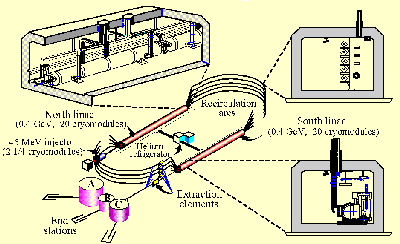 [Previous Section]
[Previous Section]
On June 17, Jefferson Lab's infrared free-electron laser (FEL) produced 155 W of continuous-wave (cw) power at 4.9 micron wavelength. No previous FEL had exceeded 11 W.
The device is the first in a series of high-average-power, wavelength-tunable FELs being developed at Jefferson Lab for basic science, for industrial applications, and for applied defense research. The present IR laser is planned to reach 1 kW. Envisioned upgrades would lead ultimately to an FEL reaching 20 kW in the infrared and 1 kW in the deep ultraviolet down to 0.2 microns.
FEL development is a spinoff from the lab's main mission of basic studies of the quark structure of nuclei. The superconducting radio-frequency (SRF) electron accelerator that drives the FEL derives from the technology of Jefferson Lab's 4 GeV, 200 microampere, cw main machine. The FEL accelerator is designed for 5 milliampere average current.
The FEL is laid out in a racetrack configuration to utilize energy recovery of the spent electron beam. The electrons are produced in a 350 kV DC photocathode gun and accelerated to 10 MeV in an SRF accelerating unit of 1 m active length -- a pair of five-cell SRF cavities like those in the main machine. The electrons are then accelerated to 57 MeV in a four-cavity-pair SRF cryomodule.
After the FEL, the beam can be recirculated for energy recovery and dumped at the injection energy of 10 MeV. The recirculation loop is based on the isochronous achromat used in the MIT Bates accelerator but designed with an energy acceptance of 6%. With energy recirculation, estimated power output at 3 microns is 980 W with a small signal gain of 46%.
Design values for the electron beam parameters of the kW-level IR FEL are:
Kinetic energy 42 MeV (nominal) Average current 5 mA Repetition rate 37.425 MHz Charge per bunch 135 pC Normalized transverse emittance 13 mm-mrad Longitudinal emittance 50 keV-degrees Beta function at wiggler center 50 cm Energy spread (sigma_gamma/gamma) 0.20% Peak current 50 A Bunch length (rms) 1 psec
Design values for the wiggler parameters of the kW-level IR FEL are:
Wavelength range 3.0 to 6.6 microns
Period 2.7 cm
Number of periods 40
rms K^2 0.5 (option: 1.0)
Phase noise <5 degrees rms
Trajectory wander x < +/- 100 microns
y < +/- 500 microradians
To minimize emittance-growth effects and to speed the commissioning
process, the FEL wiggler and optical cavity at the moment are placed at the
exit of the accelerator. Commissioning of the recirculation loop is planned
for this summer, as is the start of user experiments.
Envisioned applications include:
 [Next Section]
[Next Section]
Problems? Contact page owner